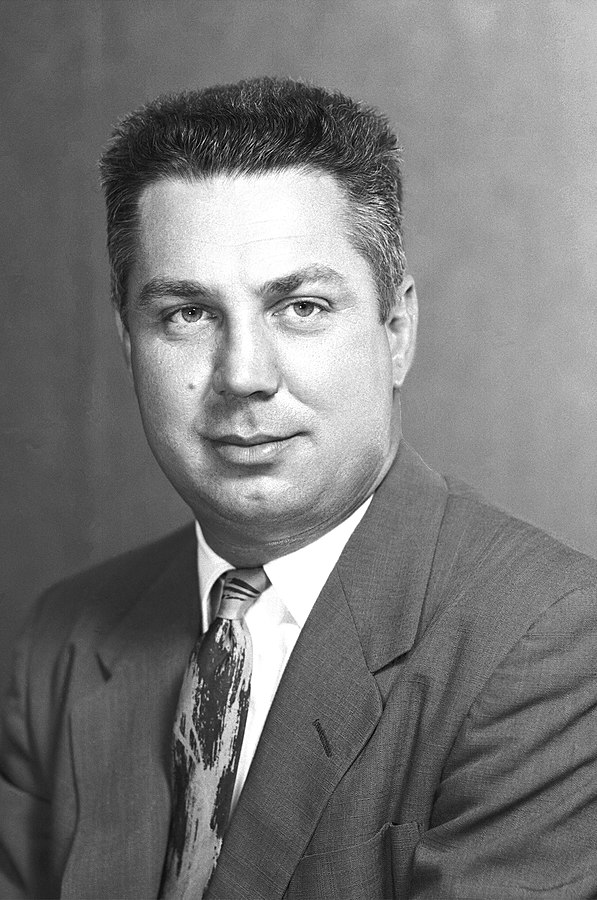Walter C. Williams was born in New Orleans, Louisiana on July 30, 1919. He received a Bachelor’s degree in Aeronautical Engineering from Louisiana State University (LSU) in Baton Rouge in 1939. In 1963, he was awarded an honorary Doctorate of Engineering degree by LSU.
After graduation, Williams worked for the Glenn L. Martin Company of Baltimore, Maryland until August 1940, when he joined the staff of the Langley Memorial Aeronautical Laboratory, part of NACA, the National Advisory Committee for Aeronautics. There he worked as an engineer in the Flight Division, improving the handling, maneuverability, and flight characteristics of fighter airplanes. Following World War II, he went to Muroc Army Air Field (now Edwards Air Force Base), California to set up flight tests for the XS-1 rocket plane (later renamed the X-1), and other experimental aircraft.
From 1946 to 1949, Walt Williams supervised the many significant research projects there. These included the first successful rocket-powered flight of the X-1, on December 9, 1946, and the record-breaking flight of Captain Chuck Yeager on October 14, 1947, the first manned mission to exceed the speed of sound. On November 14, 1949, Williams became the first Chief of the NACA High-Speed Flight Station (renamed the NASA Hugh L. Dryden Flight Research Facility in 1976.)
Walter Williams continued to supervise important research projects throughout the 1950’s. In 1954, NACA pilot Joseph A. Walker made the first of twenty research flights in the Douglas X-3. The first NACA flight in a Lockheed F-104A aircraft occurred on August 27, 1956. Williams also directed flight research programs on the Boeing B-47; the Century Series fighters, F-100, F-102, F-104, F-105 and F-107; and the X-1 #2, later renamed the X1-E.
In 1958, NACA was transformed into the National Aeronautics and Space Administration (NASA). In September 1959, Williams was appointed associate director of the NASA Space Task Group at Langley Research Center, which had been created to carry out Project Mercury. He was soon named flight operations director in Mercury Control Center at Cape Canaveral, Florida. Williams supervised more than twenty scientists and engineers, each responsible for a specific facet of space flight. As all reported directly to him during flight operations, he was able to assess all aspects of each Mercury mission.
Walt Williams directed the unmanned orbital flight of a Mercury capsule on September 13, 1961, and the two-orbit mission of the chimpanzee, Enos, on November 29, 1961. He was also flight operations director for America’s first three manned space missions, the suborbital flights of Alan B. Shepard and Virgil I. Grissom in 1961, and NASA’s first orbital flight, by John Glenn, on February 20, 1962.
In 1963, Williams transferred to NASA Headquarters as deputy associate administrator of the Office of Manned Space Flight. He left the government in 1964, and until 1975, was a vice president for the Aerospace Corporation. In 1975, he returned to NASA and until his retirement in 1982, served as its chief engineer.
Walter Williams was twice awarded NASA’s Distinguished Service Medal and was nominated both to the Meritorious Rank and Distinguished Rank in the Federal Senior Executive Service. He was honored several times by the American Institute of Aeronautics and Astronautics, receiving the Sylvanus Albert Reed Award for his contributions to supersonic and space flight in 1962, and the Haley Astronautics Award for his contributions to the advancement of space flight in 1964. His other honors include the American Astronautical Society Space Flight Award in 1978, and the 1981 Federal Engineer of the Year Award by the National Society of Professional Engineers.
On October 7, 1995, Walter C. Williams died at his home in Tarzana, California. “Walt Williams was an American aerospace pioneer of the highest order,” NASA Administrator Daniel S. Goldin told a Houston newspaper shortly afterwards. “He began serving his country during the era of piston-driven aircraft, and for the next 50 years he was at the center of events as the U.S. moved into the Jet Age and then into the Space Age. Our country owes him and his generation a debt of gratitude for all that they accomplished.”
On November 17, 1995, the Integrated Test Facility (ITF) at the Dryden Flight Research Center was renamed as the Walter C. Williams Research Aircraft Integration Facility.

